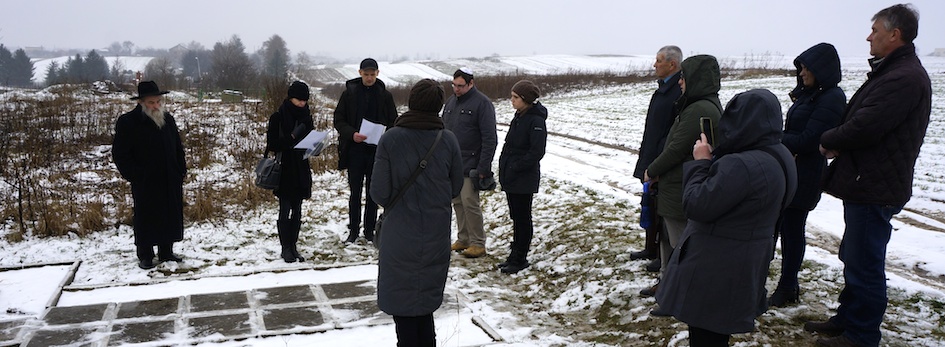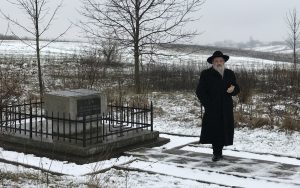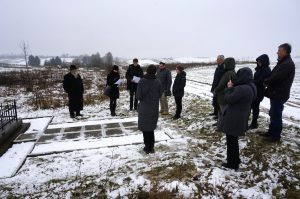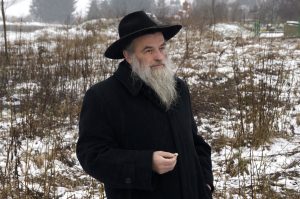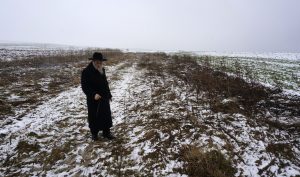Yesterday marked the 75th anniversary of the largest and deadliest of the Nazi aktions in Rohatyn. On March 20, 1942, nearly the entire Jewish community of Rohatyn was murdered beside large open pits in a field south of town center, and then buried there in the first of Rohatyn’s mass graves; more than three thousand people, including more than a thousand children, died in terror. The anniversary was marked yesterday by Rohatyn Jewish descendants and their families in Europe, Israel, and North and South America, all of whom lost ancestors and other family and friends on that day. The anniversary was also observed yesterday in Rohatyn, at the site of the killing and burial.
![]() Ця стаття також доступна українською.
Ця стаття також доступна українською.

Arriving at the southern mass grave site; meeting new friends; Mr. Vorobets and Sasha clear snow from the monument before the ceremony. Photos © 2017 Jay Osborn.
At 12:30pm, Rabbi Moyshe Kolesnyk of Ivano-Frankivsk led a modest ceremony before a group of about a dozen individuals, gathered from Rohatyn, the region, and abroad. Assembled around the memorial monument erected in 1998 by Rohatyn Jewish survivors and descendants, and with a light snow falling, the group quietly listened as Rabbi Kolesnyk recited and chanted El Malei Rachamim (אֵל מָלֵא רַחֲמִים, “God, full of mercy”), a prayer for the souls of the departed and for martyrs.
Afterward, on behalf of Rohatyn Jewish descendants living abroad, I read the following statement, which was repeated in Ukrainian by our friend Ihor Klishch, a longtime local supporter of Rohatyn Jewish Heritage:
Today is a sad anniversary for all of us, regardless of whether we are grandchildren of Rohatyn Jewish families, or Ukrainians living today in this city which we cherish. 75 years ago, here on this open, windy hill, a human tragedy happened which affected all of us who have connections to this city. A great many people – young and old, men, women, and small children – died here under circumstances impossible to imagine.
For many Jewish families, the horrific events of March 20, 1942 at this site irreparably broke their connection to the town: they no longer consider Rohatyn a place to which they want to return. They no longer have family waiting for them here. For some Rohatyn Jewish families, the pain is still too great – even 75 years later – to consider ever making a visit to Rohatyn. But, moments such as this, when we meet – here – to remember together, help to lessen the pain, and to build bridges between the nations and the generations.
Today, Rohatyners and friends – Jewish and non-Jewish – have come together here to share in collective memory of those who suffered in this place. By our actions, we also offer solace to those living abroad and in Rohatyn today, who know what happened at this place 75 years ago. History, even tragic history, is a part of who we are, and part of what we give forward to our children. We each must believe this to be true, or we would not have come here today, at this site.
On behalf of my Rohatyn families, and on behalf of Rohatyn’s Jewish children, grandchildren, and great-grandchildren living far away, thank you for joining us in this memorial event. Together we keep alive the truth, and the human values which bind us together. Thank you.
Our group then walked beyond the memorial monument to a low point in the adjacent uncultivated field, the actual site of the March 20, 1942 mass grave. There, Mykhailo Vorobets, local historian and an activist in maintaining the town’s heritage sites for decades, recounted his memories of being brought there as a seven-year-old boy by his father, some days after the executions; he described how witnessing the open pits filled with frozen bodies, through his young eyes, affected him for the rest of his life. As Mr. Vorobets has told us before, his father said to him, “You are looking upon pure evil.”

Standing at the mass grave while Mr. Vorobets relates his childhood memories of the situation 75 years ago.
Photos © 2017 Jay Osborn.
In addition to Rabbi Kolesnyk, Mr. Vorobets, Ihor, Jay, and me, the group included Sasha Nazar from Hesed’s Lviv Volunteer Center and an active member of the Lviv Jewish community; Iryna Matsevko, Deputy Director of the Lviv Center for Urban History of East Central Europe; Jennifer Dickinson, an American Fulbright scholar now in Lviv, and a descendent of Eastern European Jewish immigrants; Ben Cohen, an American Fulbright student in Kiev researching Jewish history and identity; Casey Alexa Peel, an American Peace Corps volunteer now working in Rohatyn; Olha Blaha-Maletska, representing the City of Rohatyn in her capacity as director of the regional history museum Opillya; and Vitaly Shkurko, our driver and a long-time friend of our program.
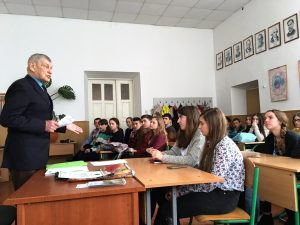
Mr. Vorobets during his history lecture to Rohatyn high school students. Photo © 2017 Jennifer Dickinson.
About an hour later, our group went to Rohatyn’s Gymnasium (high school) where Mr. Vorobets delivered a lecture about Rohatyn’s prewar multi-ethnic population. About 40 students and their teacher were present, along with the Director of the Gymnasium. Mr. Vorobets spoke passionately about the prominence of Jewish students at Rohatyn’s Ukrainian and Polish schools, including this Gymnasium, showing examples of prewar academic documents. He also spoke about the 500 years of Jewish history in town, and about the abundance and variety of Jewish professionals and businesses in Rohatyn (shopkeepers, merchants, doctors, lawyers, and pharmacists), and Jewish involvement in civic life. The 45-minute lecture concluded on the destruction of Rohatyn’s Jewish community and the need for students to know about this history and remember those who had contributed so much to the richness of Rohatyn’s academic, cultural, and professional life. Mr. Vorobets handed out copies of a very recent article written for the local newspaper by Olha Verbiana, from his research and from the Rohatyn Yizkor book (“The Story of a Bunker”), as an example of local history in need of further study and exposition.
Wartime witness testimonies, and Mr. Vorobets’ own recollections at the mass grave site yesterday, highlight the importance of remembrance and recording as ongoing duties in the present and the future. At one point in his retelling of the mass burial while we stood at the site, he paused and said, “I have to confess I made a mistake.”
We were puzzled, but he went on to say that for years after the war, the grass which grew over the mass grave there was different than that in the surrounding fields, so it was easy to see exactly where the grave was located, and its size. He said it didn’t occur to him or anyone else to make a permanent mark of the boundaries of the grave, and now the visible traces are gone. Out of respect, the local farmers avoid planting in the area, but precise knowledge of the specific spot is lost. “Now it will take experts to find it again.” Mr. Vorobets knows, of course, that Rohatyn Jewish Heritage has commissioned a professional non-invasive survey of the site (and two other locations in Rohatyn) for late May of this year, hoping to determine the mass grave boundaries and to make that information available to the City and the public as a first step toward ensuring long-term memory and protection at each of the extermination sites. That research will be done in cooperation with the City and with regional volunteer groups over a 9-day period, with analysis and reporting to follow.
For this memorial event in Rohatyn, we again used social media to help us join with others and to communicate our plans with Rohatyn teachers, students, librarians, and residents. We are particularly grateful to our friends at LawCraft Legal Services LLC in Lviv for working with the City of Rohatyn on logistics and scheduling of the event, and to Olha Blaha-Maletska for her aid and support on behalf of the City. We are especially thankful for those who stood with us at the site on this anniversary, in spirit with many others remembering in their own ways around the world.
Video: Our friend Jennifer Dickinson recorded the memorial events at the mass grave site and gave us a copy of her recording. Here are two excerpts from her recording:
Rabbi Kolesnyk: El Malei Rachamim (אֵל מָלֵא רַחֲמִים, “God, full of mercy”)
Marla Raucher Osborn: Memorial for the Jewish Community of Rohatyn
